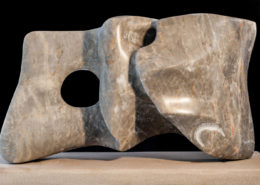Flowers of the Stone
“Flowers of the Stone” is a collection of twelve “Prosopa” on Parian Marble.
Flowers of the Stone” is a collection of twelve “Prosopa” on Parian Marble.
The Parian Marble is the divine element, which comes out of the heart of the Greek Island Paros and has given substance to the most exciting sculptures of Greek Antiquity. The Cycladic Idols, the Elgin Marbles, Aphrodite of Melos, Hermes of Praxitelis are some of the many masterpieces made from Parian Marble, also known as Lychnites due to its smoothness and transparency.
The ancient marble quarry of Marathi supplied famous Parian Sculptors with marble for more than 27 centuries, from the Geometric period up to the end of Byzantium, when probably it ran out of its fine quality. However, even during the last century it produced the marble of Napoleon’s tomb.
The sculptors of the classical antiquity used to do a part of their curving down there, into the dark underground galleries of the quarry, by the light of the candle (Lychnos), in order to make the mass of the marble lighter and easier for transportation to the surface, where they completed their work. So, they left a certain quantity of “latepes,” small pieces of this precious element, inside the galleries and around the quarry.
These pieces were for me a great challenge. The process of finding them and collecting them was by itself a rich journey through history. Handling them with the proper love and respect permitted me, day by day, to explore the force, which was hidden inside of them for centuries. These small pieces did not serve me as elements in order to illustrate on them a real or a mythical character, which I had in mind. They rather stood as individuals, possessing the power to challenge my individuality to move towards them and transform them both of us into “Prosopa.”
The individual stands before the individuality of the others, their face, and is able to reach them, to love them, to share life with them, when he is able to step out of his atomocentric barriers. In that he becomes a person, he becomes “Prosopa.”
That is why these 12 faces are constantly changing their expressions as the light reflects on them from a moving source – whether it is the sun, the moon or the light of your eyes and your heart. In this sense they not only overpass the limitations of space and time, ethnic or cultural differences, but they propose the personal dimension of the human being as a way of approaching, communicating, sharing and celebrating life.
The name of my collection “Flowers of the Stone” derives from the following poem of the Nobelist George Seferis, where he reflects the same experience:
Flowers of the rock, figures
that came when no own spoke
and spoke to me
that let me touch them
after the silence
among pine trees, oleanders
and plane-trees.
Aristides Varrias







